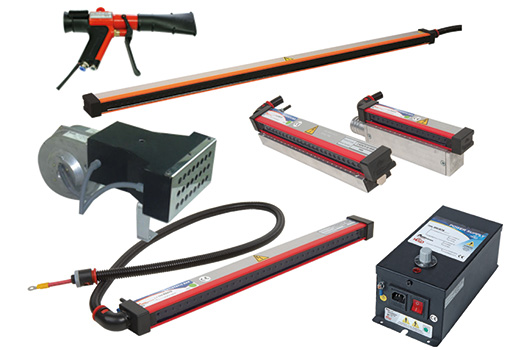Anti-Static Elimination Methods

Passive Ionization
If a charged object is approached to a conductor, it will give its charges. Radioactive sources like polonium cause the neutralization of the air that is around surface static charges. A disadvantage of the radioactive eliminators is to last only for one year. So they have to regenerate each year.
Passive Ionization
If a charged object is approached to a conductor, it will give its charges. Radioactive sources like polonium cause the neutralization of the air that is around surface static charges. A disadvantage of the radioactive eliminators is to last only for one year. So they have to regenerate each year.
Active Electrical Ionization
By using AC or DC high voltage, ionized air is produced for neutralising surface electrical charging.
AC Eliminators
AC Eliminators work at source frequency. You can make main voltage increase from 110 or 240 V to 4.5 or 7 kV by using transformer. High voltage is given to the points of the bar while the bar is grounded.(Figure 1)
If you examine the positive part, you can see the electrode point has a higher voltage than the earth point. So there will be a strong electric field between these two points. The molecules are sprayed from the electrode point, according to their charges.
If you examine the negative part, negative ions occur on the electrode point. Thus, as in figure 1 is shown, there will be a stack formed around the ionized pin that has both negative and positive ions. Without external effects, positive and negative ions affect each other and then neutralize or go through the earth. Furthermore, if there is an electrical charge, ions with opposite charge will be attracted. Then, electrons on the surface move and make the surface neutral.
Figure 1. AC Ionization
Ionization is free of surface, so ions are produced whether charges on the surface is near or far. The result is the neutralization of all surface.This is an advantage for passive eliminators.
Pulse DC Eliminators
Like AC eliminators, they are used for producing ionized air by using high voltage. AC eliminators work at source frequency, pulse DC eliminators work at lower frequencies. (Figure 2)
When you analyse the positive part of the output wave of the power source, you can see that the control unit get the high voltage connected to positive transmitter. Thus, an electric field is created between grounded object and transmitting point. This field is very strong at the sharp point of the transmitter. They produce positive ions and make them move away.
Figure 2. Pulsed DC Ionization
At the negative part, power supply gives high negative voltage to the transmitting part. Like AC eliminator, transmitting part produces negative ions. An object charged static repulses or attracts ions. When ions reach the charged surface, the neutralization starts.
Pulsed DC eliminators provide wide range ionization at low frequencies. The distance between negative and positive ions on the bar decreases the probability of the connection or joining again.
At further distances from the bar, less ions are sent to the static charged surface. So, in dynamic applications and using pulsed DC eliminators, distance between bar and surface is less important.
Another specification of Pulsed DC systems is to be able to change the output wave form and increase or decrease the time of the positive or negative parts. For example, if it is known that the object is positive, the time of the negative part of the output is increased or decreased. This time will make the quantity of the negative ions increase and positive ions decrease. This provides that the neutralization is more effective than before.
